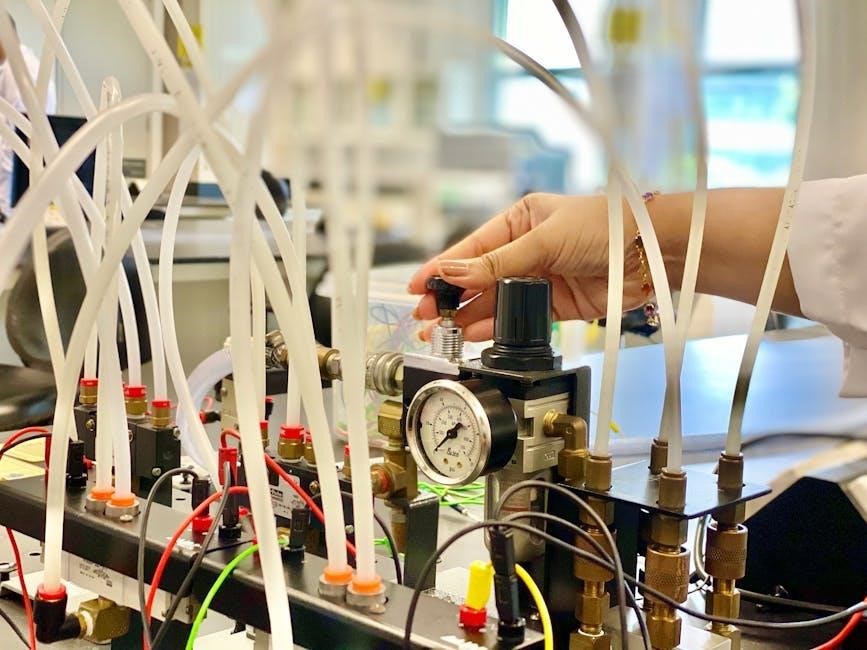Understanding Mechanical Aptitude Tests
Mechanical aptitude tests assess problem-solving skills and knowledge of mechanical principles․ They evaluate understanding of levers, pulleys, gears, and electrical systems․ These tests are crucial for technical roles․
Free PDF guides and practice tests are available online, offering sample questions with detailed answers․ Topics include springs, hydraulics, and thermodynamics, helping candidates prepare effectively․
Such resources provide insights into test formats, ensuring candidates understand the concepts and improve their reasoning abilities․ They are essential for acing mechanical aptitude assessments․
Mechanical aptitude tests evaluate problem-solving skills and understanding of mechanical principles․ They assess knowledge of levers, pulleys, gears, and electrical systems․ These tests are essential for roles requiring technical expertise․ Free PDF guides and practice tests are available online, offering sample questions with detailed explanations․ Topics covered include springs, hydraulics, and thermodynamics․ Such resources help candidates prepare effectively and improve their reasoning abilities․ They provide insights into test formats, ensuring a comprehensive understanding of mechanical concepts․ These tools are vital for excelling in mechanical aptitude assessments and securing technical positions․
Key Characteristics of Mechanical Aptitude Tests
Mechanical aptitude tests are designed to assess problem-solving skills and practical knowledge of mechanical systems․ They typically feature multiple-choice questions, true/false statements, and problem-solving scenarios․ Many tests include diagrams and blueprints, requiring interpretation and application of mechanical principles․ Time limits are common, simulating real-world conditions․ The questions cover a range of topics, from basic levers and pulleys to complex hydraulic systems․ Answers often require calculations and understanding of physical laws․ These tests evaluate both theoretical knowledge and hands-on reasoning abilities, making them essential for technical roles in engineering and mechanics․

Key Topics Covered in Mechanical Aptitude Tests
Mechanical aptitude tests cover levers, pulleys, gears, springs, and hydraulic systems․ They also include thermodynamic principles, material properties, and basic electrical systems to assess practical knowledge and reasoning skills․
Lever and Pulley Systems
Lever and pulley systems are fundamental concepts in mechanical aptitude tests․ These systems involve the use of levers, pulleys, and ropes to either change the direction or magnitude of force․ Levers operate on the principle of moments, where the product of the force and its distance from the pivot determines rotational motion․ Pulleys, on the other hand, use wheels with grooved rims and ropes to lift or move loads more efficiently․ Understanding how these systems work together is crucial for solving problems related to mechanical advantage and torque․ Practical questions often involve calculating the effort required to lift a load or determining the mechanical advantage of a pulley system․ These topics are essential for assessing a candidate’s ability to apply basic mechanical principles to real-world scenarios․ The Internet provides numerous resources, including PDF guides and practice tests, that offer sample questions and detailed explanations to help individuals master these concepts․ By practicing these types of problems, candidates can improve their problem-solving skills and enhance their performance in mechanical aptitude tests․
Gears and Gear Ratios
Gears and gear ratios are critical components in mechanical aptitude tests, focusing on how gears interact to transmit power and change speed or torque․ Gear ratios are calculated by dividing the number of teeth on the driven gear by the number of teeth on the driving gear․ A higher ratio increases torque but reduces speed, while a lower ratio does the opposite․ These concepts are essential in understanding mechanical systems, such as transmissions and machinery․ Practice questions often involve calculating gear ratios, determining output speed, or identifying the type of gear system․ Resources like PDF guides and online tests provide sample problems and explanations to help candidates master these concepts․ Understanding gear mechanics is vital for assessing mechanical reasoning and problem-solving abilities in technical roles․
Spring and Pressure Concepts
Spring and pressure concepts assess understanding of force, displacement, and energy storage in springs․ Hooke’s Law, which states that force is proportional to displacement (F = -kx), is a cornerstone․ Questions often involve calculating spring force, compression, or extension․ Pressure concepts focus on force distribution over an area (P = F/A), with common units like Pascals․ Problems may include determining pressure in hydraulic systems or cylinders․ These topics evaluate the ability to apply mechanical principles to real-world scenarios, such as engine components or machinery․ Practice questions in PDF guides and online resources help refine problem-solving skills in these areas․
Hydraulic and Pneumatic Systems
Hydraulic and pneumatic systems test understanding of fluid and air-based mechanisms․ Hydraulic systems use incompressible fluids to transmit force, while pneumatics rely on compressible gases․ Questions cover principles like Pascal’s Law, pressure multiplication, and component functions (e․g․, cylinders, pumps, valves)․ Pneumatic systems often involve air pressure, flow rates, and actuators․ Problems may include calculating system pressures, flow rates, or determining the force output of cylinders․ These topics evaluate knowledge of fluid dynamics and mechanical system applications in industrial machinery and equipment․ Practice PDFs provide exercises to master these concepts effectively․
Basic Electrical Systems
Basic electrical systems assess understanding of fundamental concepts like circuits, voltage, current, and resistance․ Questions often involve Ohm’s Law, circuit types (series/parallel), and component identification (e․g․, resistors, capacitors)․ Topics also include electrical safety, wiring diagrams, and motor operation․ Problems may require calculating power, identifying short circuits, or determining the correct wire gauge․ These questions evaluate familiarity with electrical principles and troubleshooting skills․ Practice materials, such as PDF guides, provide exercises to enhance problem-solving abilities and knowledge of electrical systems in mechanical applications․
Thermodynamic Principles
Thermodynamic principles assess understanding of energy, heat, and their interactions․ Key topics include the Laws of Thermodynamics, focusing on energy conservation and entropy․ Questions often involve calculating efficiency, heat transfer, and energy conversions in systems like engines and refrigerators․ Problems may require analyzing cycles, such as Carnot or Rankine, and determining work-output or heat-input․ These questions evaluate the ability to apply thermodynamic laws to mechanical systems, ensuring a strong foundation in energy-related problem-solving․ Practice materials, like PDF guides, provide exercises to master these essential concepts․
Material Properties and Applications
Material properties and applications test knowledge of various materials’ characteristics, such as strength, durability, and conductivity․ Questions focus on identifying suitable materials for specific mechanical applications, considering factors like load-bearing capacity, thermal resistance, and cost․ Common topics include metals, plastics, and composites, highlighting their uses in construction, machinery, and electronics․ Understanding material limitations and optimal uses is crucial․ Practice questions often present scenarios requiring material selection based on given constraints, ensuring practical problem-solving skills for real-world engineering challenges․

Types of Questions in Mechanical Aptitude Tests
Mechanical aptitude tests include multiple-choice, true/false, and fill-in-the-blank questions, as well as problem-solving scenarios and diagram interpretation, assessing both knowledge and practical application skills․
Multiple-Choice Questions
Mechanical aptitude tests often feature multiple-choice questions (MCQs) designed to assess knowledge of mechanical principles and problem-solving skills․ These questions present a scenario or concept, offering several potential answers, with only one correct option․ Common topics include lever systems, gear ratios, and hydraulic systems․ MCQs are structured to evaluate understanding of fundamental concepts, application of formulas, and the ability to interpret diagrams․ They are timed and require quick, accurate decisions․ Practice materials like PDF guides provide numerous MCQ examples, helping candidates familiarize themselves with the format and improve their response speed and accuracy․
True/False and Fill-in-the-Blank Questions
True/False and fill-in-the-blank questions are integral to mechanical aptitude tests, testing specific knowledge and recall․ True/False questions assess understanding of factual statements about mechanical concepts, such as material properties or hydraulic systems․ Fill-in-the-blank questions require candidates to provide precise terms or formulas, evaluating their ability to recall details accurately․ These formats are commonly found in PDF study guides and practice tests, helping candidates refine their knowledge of mechanical principles and terminology․ They are effective for identifying gaps in foundational understanding, ensuring preparedness for technical roles․
Problem-Solving Scenarios
Problem-solving scenarios in mechanical aptitude tests present practical, real-world situations requiring the application of mechanical principles․ These questions often involve calculating gear ratios, determining torque, or identifying the correct tool for a task․ Candidates must analyze the problem, apply relevant formulas, and select the most appropriate solution․ Such scenarios assess critical thinking and the ability to translate theoretical knowledge into practical applications․ They are commonly included in PDF guides and practice tests, helping candidates evaluate their readiness for hands-on technical challenges in industrial or engineering roles․ These questions are crucial for measuring problem-solving efficiency and accuracy․
Diagram and Blueprint Interpretation
Diagram and blueprint interpretation questions test the ability to read and understand technical drawings and schematics․ Candidates are asked to identify components, measure dimensions, or determine assembly processes․ These questions evaluate spatial reasoning and the ability to visualize mechanical systems․ Practice with sample diagrams is essential, as it improves familiarity with symbols, notations, and standard conventions․ PDF guides often include such exercises, helping candidates refine their skills in interpreting complex mechanical illustrations․ Accurate interpretation is critical for success in technical roles, making this a key focus in preparation materials․ Regular practice enhances visual and analytical skills․

Sample Questions and Answers

Sample questions and answers provide practical insights into test formats and solutions․ Reviewing these examples helps candidates understand common question types and improve problem-solving skills effectively․
Example 1: Lever and Pulley Systems
A sample question: “A lever with a mechanical advantage of 4 is used to lift a 100 N load․ What is the effort required?” The answer: E = Load / Mechanical Advantage = 100 N / 4 = 25 N․ This demonstrates how levers reduce the force needed․ Pulley systems similarly use ropes and wheels to change the direction or amount of force․ Understanding these principles is crucial for solving mechanical aptitude test questions effectively․ Practice with such examples helps improve problem-solving skills and familiarity with test formats․
Example 2: Gear Ratios and Speed Calculations
A sample question: “A gear with 20 teeth meshes with a gear with 40 teeth; If the smaller gear rotates at 100 RPM, what is the speed of the larger gear?” The answer: Speed = (Smaller Gear Teeth / Larger Gear Teeth) × RPM = (20/40) × 100 = 50 RPM․ This illustrates how gear ratios affect speed and torque․ Practicing such problems helps candidates master mechanical relationships and improve their test-taking efficiency․ Understanding gear ratios is essential for solving real-world mechanical aptitude questions․ Regular practice enhances problem-solving accuracy․
Example 3: Spring Force and Compression
A sample question: “A spring with a spring constant of 100 N/mm is compressed by 5 mm․ What is the force exerted by the spring?” Using Hooke’s Law, F = kx, the force is calculated as F = 100 N/mm × 5 mm = 500 N․ This demonstrates how spring force is directly proportional to compression․ Understanding this relationship is crucial for solving mechanical aptitude questions involving springs․ Regular practice with similar problems improves problem-solving speed and accuracy․ Mastering spring force calculations enhances overall mechanical reasoning skills․
Example 5: Basic Electrical Circuits
A sample question: “A resistor with a resistance of 10 Ω is connected to a 20 V battery․ What is the current flowing through the resistor?” Using Ohm’s Law, I = V/R, the current is calculated as I = 20 V / 10 Ω = 2 A․ This question assesses understanding of fundamental electrical relationships․ Recognizing key components like resistors, capacitors, and switches is essential․ Practicing such problems helps in mastering circuit analysis, a critical skill for mechanical aptitude tests․ Regular review of basic electrical principles ensures confidence in solving similar problems․

Preparation Tips for Mechanical Aptitude Tests
Timed practice enhances problem-solving speed․ Focus on understanding mechanical principles․ Utilize online resources and guides․ Regularly review mistakes to improve weak areas․ Stay consistent and confident․
Timed Practice Sessions
Timed practice sessions are essential for improving speed and accuracy․ Use mechanical aptitude test questions and answers PDFs to simulate real test conditions․ Set a timer to match the exam duration and attempt questions without interruptions․ Focus on solving problems within the allotted time to enhance your decision-making skills․ Regular practice helps identify time management strategies and reduces anxiety․ Review your performance to understand areas needing improvement․ Consistent timed practice builds confidence and ensures readiness for the actual test․
Understanding Mechanical Principles
Understanding mechanical principles is foundational for success in aptitude tests․ Focus on concepts like forces, motion, and energy transfer․ Review basic mechanics, such as levers, gears, and pulleys, as these are frequently tested; Study thermodynamic principles, including pressure, temperature, and fluid dynamics․ Practice interpreting diagrams and blueprints to visualize mechanical systems․ Use mechanical aptitude test questions and answers PDFs to identify common topics and strengthen your grasp of fundamental theories․ This knowledge forms the basis for solving complex problems efficiently during the test․
Using Online Resources and Guides

Leverage online platforms to access mechanical aptitude test questions and answers PDFs․ Websites offer practice tests, video tutorials, and interactive tools to enhance understanding․ Utilize forums and educational blogs for explanations of complex topics․ Many resources provide timed practice sessions to simulate real test conditions․ Prioritize guides that include detailed solutions and rationales․ Regularly review and analyze your performance to identify weak areas․ Consistent practice with online materials ensures familiarity with question formats and improves problem-solving speed․ This structured approach boosts confidence and readiness for the actual test․

Reviewing Mistakes and Weak Areas
After completing practice tests, thoroughly review incorrect answers to identify gaps in knowledge․ Analyze each mistake to understand the correct approach and reasoning․ Focus on weak areas, such as mechanical principles or problem-solving strategies, and dedicate extra study time to these topics․ Use flashcards or summaries to reinforce learning․ Track progress over time to ensure improvement․ Regularly revisiting mistakes helps build confidence and reduces errors in future tests․ Persistent review is key to mastering mechanical aptitude test questions and achieving a high score․

Importance of Mechanical Aptitude Tests
Mechanical aptitude tests assess problem-solving skills, mechanical reasoning, and technical knowledge․ They evaluate a candidate’s ability to handle practical scenarios, ensuring they are suitable for technical roles․
Assessing Problem-Solving Skills
Mechanical aptitude tests evaluate a candidate’s ability to analyze and resolve technical challenges․ These exams present scenario-based questions that require logical reasoning and practical application of mechanical principles․ By solving problems involving levers, pulleys, gears, and other systems, individuals demonstrate their capacity to think critically and apply knowledge effectively․ This assessment is crucial for roles that demand hands-on troubleshooting and innovation, ensuring candidates can handle real-world mechanical challenges efficiently․ Strong problem-solving skills are often the deciding factor in technical hiring decisions․
Evaluating Mechanical Reasoning Abilities
Mechanical aptitude tests evaluate an individual’s ability to understand and apply mechanical principles to solve problems․ These exams focus on concepts like torque, friction, and energy transfer, requiring candidates to visualize and interpret how mechanical systems operate․ Questions often involve identifying the correct function of components or predicting outcomes of mechanical interactions․ This assessment helps employers determine a candidate’s ability to learn and apply technical knowledge in real-world scenarios, ensuring they can adapt to mechanically demanding roles effectively․ Strong mechanical reasoning is essential for success in engineering and technical professions․
Predicting Job Performance in Technical Roles
Mechanical aptitude tests are designed to predict how well candidates will perform in technical roles by evaluating their problem-solving skills and understanding of mechanical concepts․ These tests simulate real-world scenarios, allowing employers to assess a candidate’s ability to apply knowledge under pressure․ Strong performance on these exams often correlates with success in roles requiring hands-on mechanical skills, troubleshooting, and teamwork․ By measuring aptitude, employers can identify individuals who are likely to excel in mechanically demanding environments and contribute effectively to technical projects and operations․

Recommended Resources for Preparation
To excel in mechanical aptitude tests, utilize free PDF guides, online practice platforms, and recommended textbooks․ These resources provide comprehensive practice questions, detailed explanations, and study materials tailored for success․
- Free PDF guides
- Online practice platforms
- Recommended textbooks
Free PDF Guides and Practice Tests
Free PDF guides and practice tests are excellent resources for preparing for mechanical aptitude tests․ These materials often include sample questions, answers, and explanations, covering topics like levers, gears, and electrical systems․ Websites such as Quizlet, TestGuide, and Mechanical Aptitude Test Guide offer downloadable PDFs․ Additionally, platforms like GitHub and Scribd host a variety of free study materials․ These resources provide a cost-effective way to familiarize yourself with test formats and improve problem-solving skills․ Regular practice with these guides ensures better performance on the actual test day․
- Downloadable PDF guides
- Sample questions with answers
- Coverage of key mechanical topics
- Free access on various websites
Online Platforms for Mechanical Aptitude Practice
Several online platforms offer mechanical aptitude practice tests and resources․ JobTestPrep, Test-Guide, and Indeed Assessments provide interactive tests simulating real exam conditions․ These platforms include timed exercises, detailed explanations, and progress tracking․ Udemy and Coursera also offer courses with practice materials․ Websites like Quizlet and Khan Academy provide additional study aids․ These tools help candidates assess their skills and improve weak areas, ensuring better preparation for mechanical aptitude tests․ Regular practice on these platforms enhances problem-solving abilities and mechanical reasoning․
- JobTestPrep
- Test-Guide
- Indeed Assessments
- Udemy
- Coursera
Books and Study Materials
Several books and study materials are available to help prepare for mechanical aptitude tests․ Titles like “Mechanical Aptitude Tests” by Samual A․ Malone and “The Handbook of Mechanical Engineering” provide comprehensive practice questions and explanations․ “Mechanical Reasoning and Aptitude” by Harry Herson is another popular resource, offering practical problem-solving techniques․ These materials often include diagrams, formulas, and real-world scenarios to enhance understanding․ They are ideal for self-study and cover topics like gears, levers, and basic mechanics, ensuring a strong foundation for test success․
- Mechanical Aptitude Tests by Samual A․ Malone
- The Handbook of Mechanical Engineering
- Mechanical Reasoning and Aptitude by Harry Herson
Final Tips for Test Day
Stay calm and manage your time effectively․ Arrive early to avoid stress and ensure you have all necessary materials․ Read each question carefully, focusing on key details․ Eliminate incorrect options before selecting an answer․ If unsure, make an educated guess rather than leaving it blank․ Use the process of elimination for complex problems․ Avoid spending too much time on a single question—move forward and revisit it later if possible․ Maintain a steady pace and trust your preparation․ Confidence and strategic thinking are key to achieving the best results․
Interpreting Test Results and Improving
Analyze your test results to identify strengths and areas needing improvement․ Focus on questions you answered incorrectly to understand common mistakes․ Review the concepts covered in those questions using study materials or guides․ Prioritize weak areas and practice similar problems to build proficiency․ Use the results to refine your study plan and retake practice tests to track progress․ Continuous improvement ensures better performance in future assessments․ Understanding your mistakes is crucial for mastering mechanical aptitude concepts and achieving success in technical roles․


